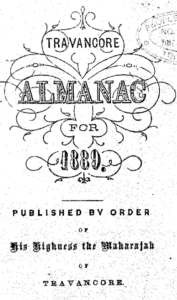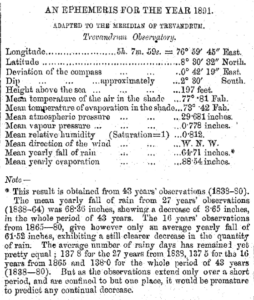Trivandrum Observatory — once recognised as a meteorological station by government — now stands as a quiet sentinel of a glorious past.
Published Nov 10, 2025 | 8:00 AM ⚊ Updated Nov 10, 2025 | 8:00 AM

Representational image. Credit: iStock
Synopsis: Researchers have unearthed forgotten records on Kerala’s Trivandrum Observatory, revealing it mapped India’s first magnetic equator in 1839 and tracked its southward shift until 1941. Founded in 1836, the observatory under John Caldecott and John Allan Broun also captured precise data on the 1859 Carrington solar superstorm, including a precursor flare, aiding modern space weather forecasts.
Nearly two centuries ago, when satellites were still a dream and the science of geomagnetism was in its infancy, a quiet hill at erstwhile princely state of Travancore was making history.
Hidden beneath the layers of time, a handful of scientists at the Trivandrum Observatory — founded in 1836 — once mapped the invisible magnetic equator that girdles the Earth.
But this feat later fell into oblivion.
Now, researchers have unearthed those long-buried records, revealing that the Trivandrum Observatory not only charted Earth’s shifting magnetism but also captured rare data from the 1859 solar superstorm, offering fresh insight into how Kerala once stood at the forefront of global geomagnetic research.
Long before satellites orbited the skies and Doppler radars scanned monsoon patterns, a quiet hilltop in Thiruvananthapuram once stood at the frontier of global scientific discovery.
Established in 1836 during the reign of erstwhile Travancore king Swathi Thirunal, the Trivandrum Observatory — perched nearly 200 feet above sea level — was not merely an astronomical outpost but a pioneering centre for studying the Earth’s magnetism.
The Travancore State Manual (1940) records that the institution was conceived to harness a rare geographic advantage: passage of the magnetic equator through Travancore.
The idea was the brainchild of John Caldecott, then Commercial Agent to the Travancore Government, who became the state’s first Government Astronomer.
Under his watch, and with Colonel Horsely of the Madras Engineering Service supervising construction, the observatory took shape on the highest hill in Trivandrum — while later became knows as Observatory Hill.
At first, the observatory was a modest establishment — performing celestial calculations and publishing the Astronomical Ephemeris or Travancore Almanac from 1838.

Travancore Almanac 1889
This publication, modeled after the Nautical Almanac, was so influential that a small printing unit was started for it — the very seed that would grow into the Government Press of Travancore.
The turning point came in 1841, when precision instruments like the Transit Circle were installed.
Caldecott’s meticulous astronomical, meteorological, and magnetic observations — sent to the Royal Society of London and the East India Company — positioned Trivandrum on the global scientific map.
But it was John Allan Broun, FRS, who succeeded Caldecott in 1852, who elevated the observatory to international prominence.
A physicist of repute and former Director of the Makerstoun Observatory in Scotland, Broun transformed Trivandrum into a first-rate magnetic observatory.
He also established the Agasthya Malai Observatory, perched 6,200 feet high in the Western Ghats, creating one of the earliest dual-site magnetic observation networks in Asia.
From his station in Trivandrum, Broun meticulously measured variations in the Earth’s magnetic field — pioneering work that helped the world understand geomagnetism’s link to solar and atmospheric phenomena.
His magnetic survey of Travancore remains a landmark in the annals of early Indian science.
Even after his retirement in 1865, Broun continued to publish his extensive data in Europe, ensuring that Trivandrum’s findings reached the wider scientific community.
Yet, with his departure, the observatory’s magnetic instruments fell silent.
The Travancore Administration Report (1865–1869) sadly notes the closure of the institution and the dispersal of its prized instruments.
The Trivandrum Observatory — which was once recognised as a meteorological station by the Government of India — now stands as a quiet sentinel of a glorious past.
In its early years, it did not merely measure the stars; it mapped the invisible heartbeat of the Earth itself — the magnetic rhythm that still hums beneath our feet.
Now, after a gap of more than a century, a group of researchers has revived a remarkable chapter in India’s scientific history.
They claim, they brought to light a forgotten scientific milestone from Kerala’s past — the first ground-based mapping of the magnetic equator in India, carried out in 1839 by the Trivandrum Observatory, now known as the Astronomical Observatory under University of Kerala.
Led by Professor R Jayakrishnan, the current director of the observatory and head of Kerala University’s Department of Physics, the researchers unearthed over 40 original publications and scientific documents from archives in Scotland, Germany, and Munich University — none of which were said to be available in India.
Among the discoveries was a pencil sketch of a magnetic observatory once located in Cherthala, found at the National Library of Scotland.

Some readings from the Observatory figured in the Travancore Almanac 1890
The sketch and the recovered records helped the team retrace the observatory’s pioneering role in global geomagnetic studies.
The research, published in the Indian Journal of History of Science under the title “162 Years of Rendezvous with the Magnetic Equator by the Travancore Observatory,” reveals that the institution meticulously recorded the magnetic equator’s shifting path between 1839 and 1941.
The first map of India’s magnetic equator, published in 1839, was a collaboration between John Caldecott, then director of the Travancore Observatory, and TG Taylor of the Madras Observatory.
Their findings identified Bolgatty in Ernakulam on the west coast and Manamelkudi in Pudukkottai, Tamil Nadu, on the east coast as points along the magnetic equator.
Later, in 1859, John Allan Broun, Caldecott’s successor, reported that the magnetic dip equator — where Earth’s magnetic field is perfectly horizontal — had shifted to Cherthala in Alappuzha.
By 1921, it was recorded in Thiruvananthapuram, confirming a steady southward migration toward Sri Lanka.
According to the researchers, the Trivandrum Observatory may be the only institution in the world to have recorded the migration of the magnetic equator directly over its geographical location.
These early records not only charted Earth’s shifting magnetic behavior but also provided crucial evidence supporting the concept of geomagnetic reversal — the gradual swapping of Earth’s magnetic north and south poles.
Back in July, the Observatory drew global scientific attention after researchers from the University of Kerala uncovered a long-overlooked chapter in space weather history.
Led by Jayakrishnan, the team unearthed 19th-century magnetic logs that offered new insight into the legendary 1859 Carrington Event — the most powerful geomagnetic storm ever recorded.
Their study, published in Advances in Space Research, revealed that the observatory’s instruments had captured not only the main storm on 2 September, 1859, but also an earlier, lesser-known solar flare on 28 August.
Long dismissed as minor, this precursor disturbance, the team found, had actually destabilised Earth’s magnetic environment, effectively setting the stage for the devastating impact of the Carrington Event days later.
What made Thiruvananthapuram’s data invaluable was the exceptional precision of its readings — recorded every 2-5 minutes, compared to the 5-minute intervals at Mumbai’s Colaba Observatory.
It has to be noted that in the Travancore State Manuel it has been mentioned that the Observatory is equipped with self-recording instruments for continuous registration of pressure, temperature, humidity, wind-velocity, wind-direction and rain-fall.
“The results of the daily observations are published in the Indian Daily Weather Report and also incorporated in the monthly and annual Weather Reviews published by the India Meteorological Department. A daily weather report is also issued from the Observatory; and a summary of the principal meteorological results and general weather is published weekly in the Government Gazette,” it says.
Using modern geomagnetic modelling, the team reconstructed how the twin solar outbursts interacted with Earth’s magnetic field more than 160 years ago.
These findings not only reestablished Kerala’s forgotten role in early solar storm research but also highlighted the importance of digitising and reanalysing archival data in the age of satellite technology.
The researchers then stated that the observatory’s rediscovered records are helping scientists better anticipate the impact of future solar mega-storms — rare but potentially catastrophic events capable of crippling modern communication and power networks worldwide.
The rediscovery of the Trivandrum Observatory’s lost records is more than a nostalgic glance at Kerala’s scientific past — it’s a reminder that the quest to understand Earth’s magnetic heartbeat began here nearly two centuries ago.
The hilltop observatory now stands as a bridge between eras — where history, and human curiosity continue to converge.
(Edited by Amit Vasudev)
